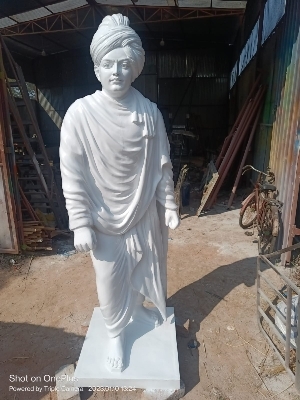Call us now
Swami Vivekananda Statue
18000 INR/Piece
Product Details:
- Dimension (L*W*H) 18 × 18 × 72 inch
- Length 18 inch
- Plating Other
- Surface Texture Smooth
- Finish Type Glossy
- Usage & Applications Decoration
- Plastic Type Resin
- Click to View more
X
Swami Vivekananda Statue Price And Quantity
- 1 Piece
- 18000 INR/Piece
Swami Vivekananda Statue Product Specifications
- Indian
- FRP
- Yes
- Handmade
- 15 kg
- White
- Glossy
- 72 inch
- Smooth
- Standard
- Sculpture
- Other
- Decoration
- Resin
- 18 × 18 × 72 inch
- 18 inch
- 18 inch
- Modern Arts, Professional, Artificial
- Park, Garden Decoration, Home Decoration
- High Quality
- Other
- Iron
Swami Vivekananda Statue Trade Information
- Cash in Advance (CID)
- 100 Piece Per Month
- 7 Days
- Sample costs shipping and taxes has to be paid by the buyer
- Asia
- All India
Product Description
An FRP (Fiber Reinforced Plastic) Swami Vivekananda statue is a popular and enduring representation of the revered Indian spiritual leader and philosopher. These statues are chosen for their unique blend of aesthetic versatility, durability, and cost-effectiveness. Here's a detailed description of an FRP Swami Vivekananda statue: FRP Swami Vivekananda Statue Description An FRP Swami Vivekananda statue typically embodies the serene wisdom, profound strength, and inspiring presence of the monk who introduced Vedanta and Yoga to the Western world. These statues are widely placed in educational institutions, spiritual centers, public parks, and homes across India and beyond. Iconography and Pose: Swami Vivekananda statues commonly depict him in a few iconic poses, each conveying a specific aspect of his personality and teachings: * Standing with Folded Arms (The "Chicago Pose"): This is perhaps the most famous and recognizable pose, often associated with his historic address at the Parliament of the World's Religions in Chicago. In this pose, his arms are typically crossed over his chest, conveying: * Composure and Serenity: A calm, collected demeanor. * Deep Thought and Introspection: A sense of profound contemplation. * Authority and Confidence: A strong, unwavering presence. The facial expression often reflects a blend of intensity, compassion, and a penetrating gaze. His monastic robes (ochre or white) are typically depicted with naturalistic drapes and folds. * Standing with One Hand Raised in a Gesture of Blessing or Speech (Vyakhyana Mudra): This pose emphasizes his role as a teacher and orator. His hand might be raised as if delivering a discourse, symbolizing wisdom, guidance, and the imparting of knowledge. * Seated in Meditation or Contemplation: Less common for large public statues but sometimes found in smaller, indoor versions, this pose highlights his spiritual depth and meditative practices. * Walking/Striding: Occasionally, he is depicted in a dynamic walking pose, symbolizing his journey, his active engagement with society, and his tireless work. Appearance and Detailing: * Facial Features: Sculptors strive to capture his distinctive features: a strong jawline, a prominent forehead, often a serene or thoughtful expression, and piercing eyes that convey intellect and spiritual insight. His hair is typically short and neat. * Drapery of Robes: The simplicity of his monastic attire is often rendered with great attention to the flow and fall of the fabric, adding to the statue's realism and grace. * Symbolic Elements: While less common than with deities, sometimes subtle elements like a lotus base (symbolizing purity and spiritual growth) or books might be incorporated. * Finish and Color: FRP statues offer immense flexibility in finishing. They can be: * Bronze Effect: Painted and textured to mimic the rich, aged look of traditional bronze, complete with verdigris patination, providing a classic and dignified appearance. * Stone Effect: Finished to resemble marble, granite, or sandstone, offering a timeless and monumental feel. * Naturalistic (Skin Tones): While less frequent for prominent public statues, some designs might incorporate more lifelike skin tones. * Custom Colors: For specific themes or artistic interpretations, they can be painted in vibrant or unique colors. Material Advantages (FRP specific): * Lightweight: FRP is considerably lighter than solid bronze, stone, or concrete. This significantly simplifies transportation, installation, and relocation, making it feasible for rooftop installations, temporary exhibits, or areas with weight restrictions. * High Strength and Durability: Despite its light weight, FRP boasts excellent tensile strength and impact resistance. It is less prone to cracking or chipping than natural stone and does not dent like some metals. * Weather and Corrosion Resistance: This is a crucial benefit for outdoor installations in diverse climates like India. FRP is highly resistant to: * UV radiation: High-quality exterior-grade paints and coatings protect the statue from fading and degradation due to prolonged sun exposure. * Moisture and Water: It is impervious to water absorption, preventing issues like efflorescence, mold growth, or damage from freeze-thaw cycles (though less critical in most of India). * Chemicals and Pollutants: It stands up well to atmospheric pollutants and chemical exposure. * Rust and Rot: Unlike metal or wood, FRP does not rust or rot, ensuring a long lifespan with minimal deterioration. * Low Maintenance: FRP statues require relatively low maintenance. Routine cleaning with mild soap and water is generally sufficient to keep them looking pristine. * Cost-Effectiveness: Generally, FRP offers a more economical solution for creating large, detailed, and durable statues compared to traditional materials like bronze or hand-carved stone, making it accessible for a wider range of institutions and organizations. * Design Versatility: The molding process used for FRP allows for precise replication of intricate details and complex forms, ensuring that the essence and likeness of Swami Vivekananda are faithfully captured. In summary, an FRP Swami Vivekananda statue is a modern tribute that combines artistic precision and symbolic depth with the practical benefits of advanced material science, making it a fitting and enduring homage to his legacy.Tell us about your requirement

Price:
Quantity
Select Unit
- 50
- 100
- 200
- 250
- 500
- 1000+
Additional detail
Mobile number
Email




 Send Inquiry
Send Inquiry Send SMS
Send SMS